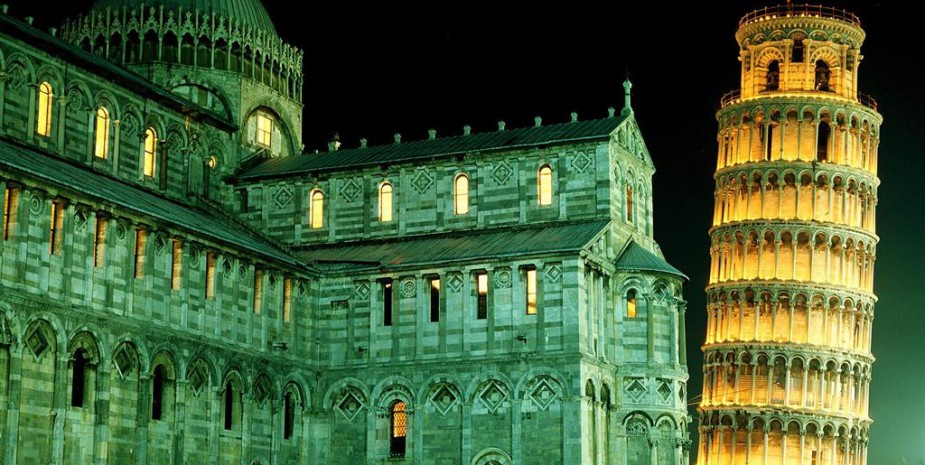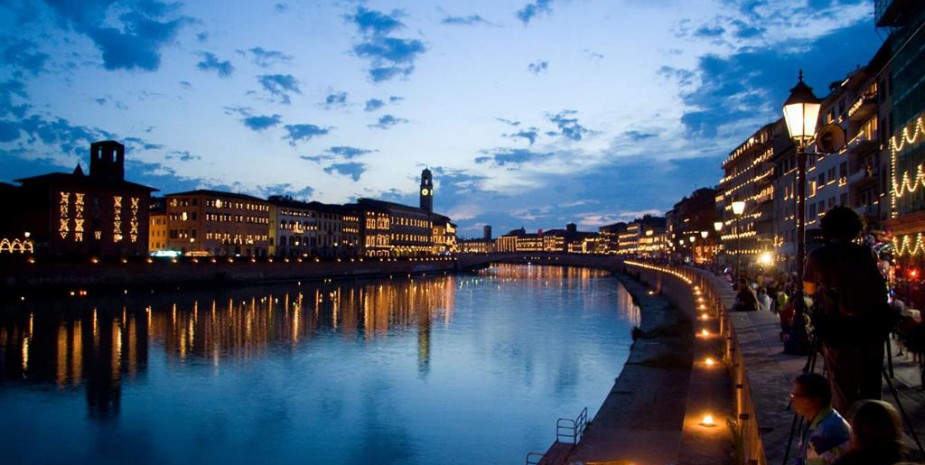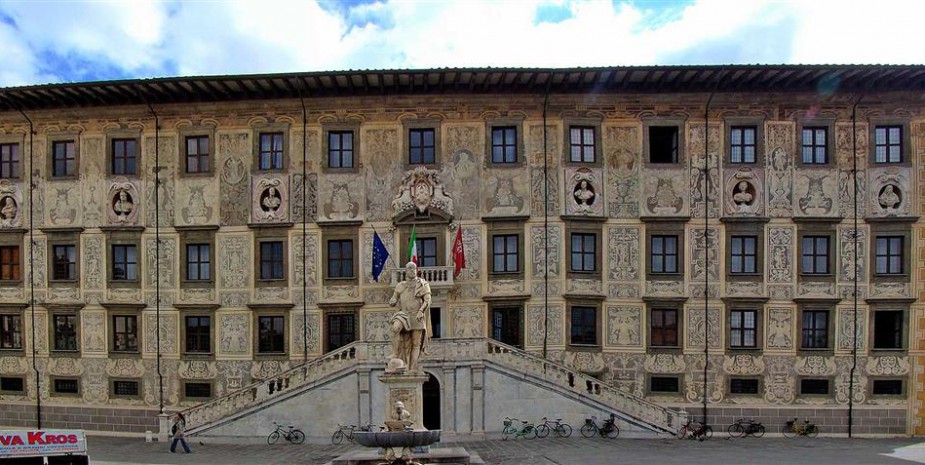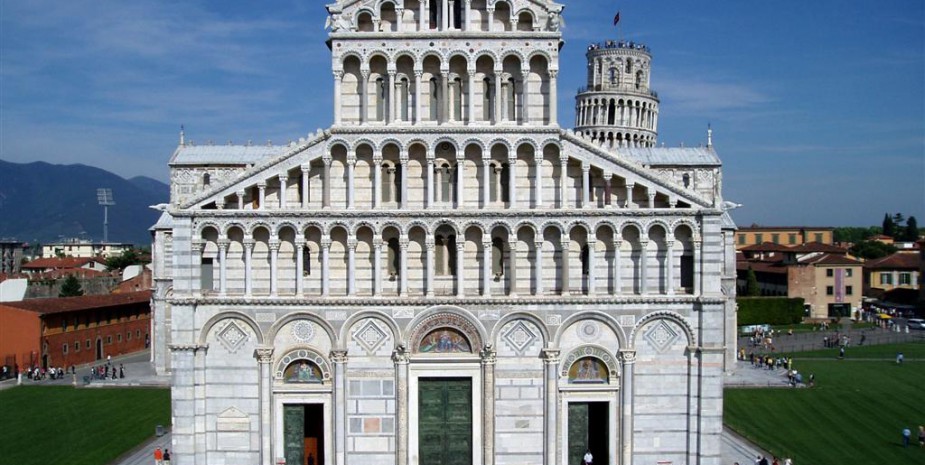Pisa
Pisa (/ˈpiːzə/; Italian pronunciation: [ˈpiːsa]) is a city in Tuscany, Central Italy, on the right bank of the mouth of the River Arno on the Tyrrhenian Sea. It is the capital city of the Province of Pisa. Although Pisa is known worldwide for its leaning tower (the bell tower of the city’s cathedral), the city of over 88,332 residents (around 200,000 with the metropolitan area) contains more than 20 other historic churches, several palaces and various bridges across the River Arno. Much of the city’s architecture was financed from its history as one of the Italian maritime republics.
The city is also home of the University of Pisa, which has a history going back to the 12th century and also has the mythic Napoleonic Scuola Normale Superiore di Pisa and Sant’Anna School of Advanced Studies as the best sanctioned Superior Graduate Schools in Italy.
Main sights The Monumental Campo Santo in the Piazza del Duomo Façade of Santa Maria della Spina St. Francis’ church Palazzo della Carovana or dei Cavalieri Cittadella vecchia
While the bell tower of the Cathedral, known as “the leaning Tower of Pisa”, is the most famous image of the city, it is one of many works of art and architecture in the city’s Piazza del Duomo, also known, since the 20th century, as Piazza dei Miracoli (Square of Miracles), to the north of the old town center. The Piazza del Duomo also houses the Duomo (the Cathedral), the Baptistry and the Campo Santo (the monumental cemetery). The medieval complex includes the above mentioned four sacred buildings, the hospital and few palaces. All the complex is kept by the Opera (fabrica ecclesiae) della Primaziale Pisana, an old non profit foundation that operates since the building of the Cathedral (1063) to the maintenance of the sacred buildings. The area is framed by medieval walls kept by municipality administration.
Other interesting sights include:
Knights’ Square (Piazza dei Cavalieri), where the Palazzo della Carovana, with its impressive façade designed by Giorgio Vasari may be seen. Sited on the square Church of Santo Stefano dei Cavalieri: Sited on Piazza dei Cavalieri, and also designed by Vasari. It had originally a single nave; two more were added in the 17th century. It houses a bust by Donatello, and paintings by Vasari, Jacopo Ligozzi, Alessandro Fei, and Jacopo Chimenti da Empoli. It also contains spoils from the many naval battles between the Cavalieri (Knights of St. Stephan) and the Turks between the 16th and 18th centuries, including the Turkish battle pennant hoisted from Ali Pacha’s flagship at the 1571 Battle of Lepanto. Church of St. Sixtus: This small church, consecrated in 1133, is also close to the Piazza dei Cavalieri. It was used as a seat of the most important notarial deeds of the town, also hosting the Council of Elders. It is today one of the best preserved early Romanesque buildings in town. Church of St. Francis: The church of San Francesco may have been designed by Giovanni di Simone, built after 1276. In 1343 new chapels were added and the church was elevated. It has a single nave and a notable belfry, as well as a 15th-century cloister. It houses works by Jacopo da Empoli, Taddeo Gaddi and Santi di Tito. In the Gherardesca Chapel are buried Ugolino della Gherardesca and his sons. Church of San Frediano: This ancient church built by 1061, has a basilica interior with three aisles, with a crucifix from the 12th century. Paintings from the 16th century were added during a restoration, including works by Ventura Salimbeni, Domenico Passignano, Aurelio Lomi, and Rutilio Manetti. Church of San Nicola: This ancient church built by 1097, was enlarged between 1297 and 1313 by the Augustinians, perhaps by the design of Giovanni Pisano. The octagonal belfry is from the second half of the 13th century. The paintings include the Madonna with Child by Francesco Traini (14th century) and St. Nicholas Saving Pisa from the Plague (15th century). Noteworthy are also the wood sculptures by Giovanni and Nino Pisano, and the Annunciation by Francesco di Valdambrino. Church of Santa Maria della Spina: This small white marble church alongside the Arno, is attributed to Lupo di Francesco (1230), is another excellent Gothic building. Church of San Paolo a Ripa d’Arno: The church was founded around 952 and enlarged in the mid-12th century along lines similar to those of the cathedral. It is annexed to the Romanesque Chapel of St. Agatha, with an unusual pyramidal cusp or peak. Church of San Pietro in Vinculis: The church St Peter in Chains, known as San Pierino, is an 11th-century church with a crypt and a cosmatesque mosaic on the floor of the main nave. Borgo Stretto: This medieval borgo or neighborhood contains strolling arcades and the Lungarno, the avenues along the river Arno. It includes the Gothic-Romanesque church of San Michele in Borgo (990). Remarkably, there are at least two other leaning towers in the city, one at the southern end of central Via Santa Maria, the other halfway through the Piagge riverside promenade. Medici Palace: The palace was once a possession of the Appiano family, who ruled Pisa in 1392–1398. In 1400 the Medici acquired it, and Lorenzo de’ Medici sojourned here. Orto botanico di Pisa: The botanical garden of the University of Pisa is Europe’s oldest university botanical garden. Palazzo Reale: The (“Royal Palace”), once belonged to the Caetani patrician family. Here Galileo Galilei showed to Grand Duke of Tuscany the planets he had discovered with his telescope. The edifice was erected in 1559 by Baccio Bandinelli for Cosimo I de Medici, and was later enlarged including other palaces. Palazzo Gambacorti: This palace is a 14th-century Gothic building, and now houses the offices of the municipality. The interior shows frescoes boasting Pisa’s sea victories. Palazzo Agostini: The palace is a Gothic building also known as Palazzo dell’Ussero, with its 15th-century façade and remains of the ancient city walls dating back to before 1155. The name of the building comes from the coffee rooms of Caffè dell’Ussero, historic meeting place founded on September 1, 1775. Mural Tuttomondo: The modern mural is the last public work of Keith Haring, on the rear wall of the convent of the Church of Sant’Antonio, painted in June 1989.
Pisa boasts several museums:
Museo dell’Opera del Duomo: exhibiting among others the original sculptures of Nicola Pisano and Giovanni Pisano and the treasures of the cathedral. Museo delle Sinopie: showing the sinopias from the camposanto, the monumental cemetery. These are red ocher underdrawings for frescoes, made with reddish, greenish or brownish earth colour with water. Museo Nazionale di San Matteo: exhibiting sculptures and paintings from the 12th to 15th centuries, among them the masterworks of Giovanni and Andrea Pisano, the Master of San Martino, Simone Martini, Nino Pisano and Masaccio. Museo Nazionale di Palazzo Reale: exhibiting the belongings of the families that lived in the palace: paintings, statues, armors, etc. Museo Nazionale degli Strumenti per il Calcolo: exhibiting a collection of instruments used in science, between whose a pneumatic machine of Van Musschenbroek and a compass probably belonged to Galileo Galilei. Museo di storia naturale e del territorio dell’Università di Pisa, located in the Certosa di Calci, outside the city. It houses one of the largest cetacean skeletons collection in Europe.
Pisa hosts the University of Pisa, especially renowned in the fields of Physics, Mathematics, Engineering and Computer Science. The Scuola Superiore Sant’Anna and the Scuola Normale Superiore, the Italian academic élite institutions are noted mostly for research and the education of graduate students.
Construction of a new leaning tower of glass and steel 57 meters tall, containing offices and apartments was scheduled to start in summer 2004 and take 4 years. It was designed by Dante Oscar Benini and raised criticism.
Distance: 58 km





 English
English Deutsch
Deutsch Français
Français Italiano
Italiano